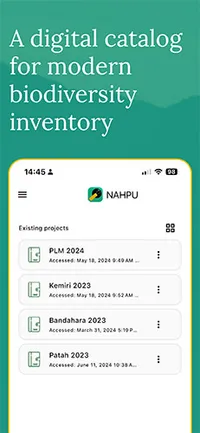Research Projects
My research integrates fieldwork, natural history collections, genomics, and the development of digital tools to address speciation, biogeography, and conservation questions. In particular, it centers on identifying patterns of small mammal diversity and understanding speciation processes within and across islands in the Indo-Australian Archipelago. I have also engaged in projects focusing on other taxa and in different regions. Most of the tools I develop are taxon-agnostic. My collaborative work involves more than a dozen people in some projects. I strive to make research using natural history collections and genomic data accessible to students and researchers with limited technical knowledge and access to computing resources.
Small Mammal Diversity & Speciation
Understanding patterns that generate species diversity within a complex island system

This project studies small mammal diversity and speciation in Sulawesi and islands on the Sunda Shelf, Southeast Asia. During the Pleistocene, the islands on the Sunda Shelf—such as Sumatra, Java, and Borneo— were connected as a continuous landmass. In contrast, Sulawesi were formed from separate islands. The isolated mountains on these islands promote other opportunities for speciation. We conduct extensive fieldwork, perform genomic studies, and describe undocumented species as necessary.
My dissertation focuses on the in-situ diversification of hill rats (the Bunomys species group) in Sulawesi. I aim to improve phylogenetic resolution and understand how the island's geological history has shaped the group's diversity. Ultimately, I aim to deepen our understanding of speciation on a large, isolated island like Sulawesi and aid conservation efforts by improving our knowledge of species diversity and endemism.
An island of islands: complex gene tree discordance and local endemism on a recent, rapid rodent radiation on Sulawesi
A new species of Frateromys from the Northern Peninsula of Sulawesi, Indonesia
Molecular and morphological systematics of the Bunomys division (Rodentia: Muridae), an endemic radiation on Sulawesi
A new species of shrew (Soricomorpha: Crocidura) from Java, Indonesia: possible character displacement despite interspecific gene flow
Local endemism and within‐island diversification of shrews illustrate the importance of speciation in building Sundaland mammal diversity
Fourteen new, endemic species of shrew (genus Crocidura) from Sulawesi reveal a spectacular island radiation
A new climbing shrew from Sulawesi highlights the tangled taxonomy of an endemic radiation
A hog-nosed shrew rat (Rodentia: Muridae) from Sulawesi Island, Indonesia
Systematics and historical biogeography of Crunomys and Maxomys (Muridae: Murinae), with the description of a new species from Sulawesi and new genus-level classification
Three new species of shrew (Soricidae: Crocidura) from West Sumatra, Indonesia: elevational and morphological divergence in syntopic sister taxa
Inclusive, Open, and Accessible Software
Developing digital tools empowering new learners in evolutionary studies

My software project spans a broad spectrum of collection-based evolutionary studies, from data collection in the field (NAHPU), species identification through innovative digital field guide (RINJA), a phylogenomic pipeline (ULLAR), genomic data wrangling and summarization (SEGUL), to taxonomic database (MDD app, website, and tooling). My goal for this project is to develop software to improve the efficiency, data integration, and accessibility of biodiversity research. Additionally, I aim to reduce the ecological footprint of genomic studies while allowing underfunded labs to benefit from the decreasing cost of genomic sequencing. The development of the apps leverages emerging technologies in software development (e.g., Rust, Flutter, and CI/CD ). Especially for genomic studies, I take advantage of advancements in CPU technology and heterogenous computing to accelerate data processing and minimize reliance on expensive and power-hungry High-Performance Computing Clusters.
NAHPU: A field cataloging application for efficient, repeatable, and inclusive collection-based evolutionary studies
ULLAR: An ULtrafast, scaLable, Accessible, and Reproducible phylogenomic pipeline
SEGUL: Ultrafast, memory-efficient and mobile-friendly software for manipulating and summarizing phylogenomic datasets
How many mammal species are there now? Updates and trends in taxonomic, nomenclatural, and geographic knowledge
GPU-Agnostic, Low-cost Machine Learning Approaches
Developing on-devices, cross-platform machine-learning methods to improve biodiversity research
Other Projects
Projects that I am involved in outside my main research
Mammalian Microbiomes and Host-Parasites Interaction
This project is part of our ongoing research on Sulawesi Island, Indonesia. We aim to understand the microbial communities in the gut regions of shrews and rodents. Additionally, we focus on detecting Trypanosoma parasites in native rodents of Sulawesi to study host-parasite interactions across elevational gradients.
Wildlife disease surveillance from village to peak: Trypanosome infections of mammals on Sulawesi revealed higher prevalence in intact montane forests
Trypanosoma (Euglenozoa: Kinetoplastea) infections in rodents, bats, and shrews along an elevation and disturbance gradient in Central Sulawesi, Indonesia
Mycoplasmataceae dominate microbial community differences between gut regions in mammals with a simple gut architecture
Native and introduced trypanosome parasites in endemic and introduced murine rodents of Sulawesi

Specimen Digitization
This project is led by Dr. Nurainas at the Herbarium Universitas Andalas (ANDA) funded through the collection and data mobilization grant provided by the Global Biodiversity Information Facility (GBIF). We aim to digitize >65,000 sheets of the herbarium specimens at ANDA and make the data accessible through the GBIF portal.
Flora of Sumatra : Vascular plant collection from Batang Toru Forest deposited in ANDA Herbarium
Flora of Sumatra: Vascular plant collection of selected families deposited at Herbarium of Andalas University (ANDA)
Flora Sumatra: Digitizing and data basing specimens of the Sumatran Flora deposited at Herbarium Universitas Andalas (ANDA)-Part 2
Genomics and Systematics of Antbirds in the Neotropics
I mentored to students: Marky Mutchler (the University of Chicago) and Ryan Zucker (Cornell University). Both of them are under the supervision of Dr. Glaucia Del-Rio, the University of Florida. We aim to understand the genomic basis of speciation and systematics of antbirds in the Neotropics. My involement is primarily in the phylogenomic analyses of the studies.